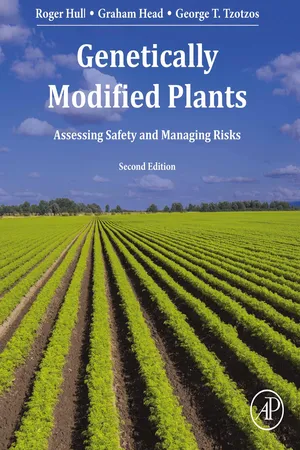
eBook - ePub
Genetically Modified Plants
Assessing Safety and Managing Risk
This is a test
- 359 pages
- English
- ePUB (mobile friendly)
- Available on iOS & Android
eBook - ePub
Genetically Modified Plants
Assessing Safety and Managing Risk
Book details
Book preview
Table of contents
Citations
About This Book
Genetically Modified Plants, Second Edition, provides an updated roadmap and science-based methodology for assessing the safety of genetic modification technologies, as well as risk assessment approaches from regulators across different agroecosystems. This new edition also includes expanded coverage of technologies used in plant improvement, such as RNA-dependent DNA methylation, reverse breeding, agroinfiltration, and gene-editing technologies such as CRISPR and TALENS. This book is an essential resource for anyone interested in crop improvement, including students and researchers, practitioners in regulatory agencies, and policymakers involved in plant biotechnology risk assessment.
- Provides a roadmap for assessing the safety of genetically modified plants
- Expands coverage of technologies used in plant improvement, such as RNA-dependent DNA methylation, Reverse Breeding and Agro-infiltration
- Introduces new chapters addressing the potential applications and associated risks of new gene editing technologies such as CRISPR and TALENS
Frequently asked questions
At the moment all of our mobile-responsive ePub books are available to download via the app. Most of our PDFs are also available to download and we're working on making the final remaining ones downloadable now. Learn more here.
Both plans give you full access to the library and all of Perlego’s features. The only differences are the price and subscription period: With the annual plan you’ll save around 30% compared to 12 months on the monthly plan.
We are an online textbook subscription service, where you can get access to an entire online library for less than the price of a single book per month. With over 1 million books across 1000+ topics, we’ve got you covered! Learn more here.
Look out for the read-aloud symbol on your next book to see if you can listen to it. The read-aloud tool reads text aloud for you, highlighting the text as it is being read. You can pause it, speed it up and slow it down. Learn more here.
Yes, you can access Genetically Modified Plants by Roger Hull,Graham Head,George T. Tzotzos in PDF and/or ePUB format, as well as other popular books in Biological Sciences & Genetics & Genomics. We have over one million books available in our catalogue for you to explore.
Information
Chapter 1: Setting the context: Agriculture and crop/food sustainability
Abstract
This chapter describes the history of agriculture and constraints on crop production, including the potential effects that climate change and population increase will have over the next few decades. By highlighting the constraints on crop production, it sets the scene for the need for new technologies, especially genetic modification and other molecular DNA techniques, to help mitigate them, and provides the background for the risk assessment and management topics described in subsequent chapters.
Keywords
History of agriculture; Constraints on crop production; Abiotic constraints; Biotic constraints; Climate change; Food sustainability
1: History of crop production
1.1: Development of modern crop productiona
Crop production is generally considered to have started during the Neolithic Period when humans moved from being hunter/gathers toward organized societies with food producers and food consumers, though some evidence is emerging of small-scale crop production at least 11 millennia earlier in the Paleolithic Period (Snir et al., 2015). Suitable wild plant species were domesticated by choosing those variants that had desirable properties (e.g., yield, reliability, lack of toxins, and ease of cultivation). Crop production originated in the primary centers of origin of the plant species (Box 1.1) being domesticated.
Over a long period of time, farmers practiced empirical crop breeding by selecting the best variants, cross-fe...
Table of contents
- Cover image
- Title page
- Table of Contents
- Copyright
- Abbreviations
- Preface
- Chapter 1: Setting the context: Agriculture and crop/food sustainability
- Chapter 2: Technologies for crop improvement
- Chapter 3: Current progress and future needs of genetically engineered crop plants
- Chapter 4: Principles of risk assessment
- Chapter 5: Evolution of regulatory systems and national biosafety frameworks
- Chapter 6: Molecular characterization of GM plants
- Chapter 7: Risk assessment and management—Human and animal health
- Chapter 8: Risk assessment and management—Environment
- Chapter 9: Risk perception and public attitudes to bioengineered crops
- Chapter 10: The future
- Appendix A: Glossary
- Appendix B: Climate change and global warming: Impacts on crop production
- Appendix C: Details of major biotic constraints
- Appendix D: Genetics and gene expression
- Appendix E: Mutations
- Appendix F: Information required on an application for environmental release of a GMO
- Appendix G: GM food labeling in different countries
- Appendix H: Differences in public uptake of GM foods
- Index
